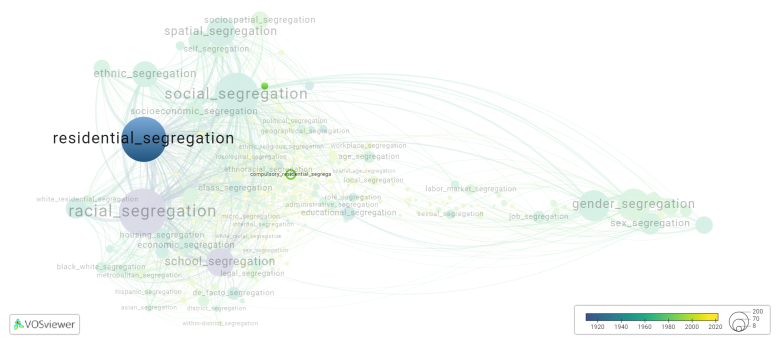Compulsory residential segregation: Difference between revisions
(Creating page) |
(Creating page) |
||
| Line 15: | Line 15: | ||
Compulsory residential segregation is frequently discussed in the literature with the following segregation forms: | Compulsory residential segregation is frequently discussed in the literature with the following segregation forms: | ||
[[ | [[residential segregation]] | ||
[[File:compulsory_residential_segregation.png|780x780px]] | [[File:compulsory_residential_segregation.png|780x780px]] | ||
| Line 21: | Line 21: | ||
For the complete network of associated segregation forms, see: | For the complete network of associated segregation forms, see: | ||
year of publication https://tinyurl.com/2235lkhw | |||
Louvain clusters https://tinyurl.com/2d8wg5n3 | |||
betweenness centrality https://tinyurl.com/223udk5r | |||
disciplines where segregation forms first appeared https://tinyurl.com/244d8unz | |||
==References== | ==References== | ||
==Notes== | ==Notes== | ||
Revision as of 14:34, 27 September 2024
Date and country of first publication[1]
1995
South Africa
Definition
Compulsory residential segregation refers to the mandated separation of individuals or groups based on certain criteria, typically race, ethnicity, religion, or socioeconomic status. It involves legally enforced policies that require individuals to live in specific designated areas or neighborhoods based on these criteria.
Historically, compulsory residential segregation has been implemented as a means of social control, oppression, and institutionalized discrimination. For example, during the era of apartheid in South Africa, laws were put in place to forcefully segregate the population along racial lines, with non-white individuals being confined to designated areas known as townships.
Compulsory residential segregation can have significant negative effects on individuals and communities. It perpetuates social inequalities, limits social mobility, and reinforces stereotypes and prejudices. Segregated neighborhoods often lack access to quality education, healthcare, employment opportunities, and other essential resources and services. This can lead to a cycle of poverty and unequal distribution of resources.
Legal and societal efforts have been made to eradicate compulsory residential segregation. In many countries, laws have been enacted to ensure equal housing opportunities and to prevent discrimination in housing based on race, ethnicity, or other protected characteristics. However, segregation still persists to varying degrees in many parts of the world, and addressing this issue remains an ongoing challenge.
See also
Related segregation forms
Compulsory residential segregation is frequently discussed in the literature with the following segregation forms:
For the complete network of associated segregation forms, see:
year of publication https://tinyurl.com/2235lkhw
Louvain clusters https://tinyurl.com/2d8wg5n3
betweenness centrality https://tinyurl.com/223udk5r
disciplines where segregation forms first appeared https://tinyurl.com/244d8unz
References
Notes
- ↑ Date and country of first publication as informed by the Scopus database (December 2023).
At its current state, this definition has been generated by a Large Language Model (LLM) so far without review by an independent researcher or a member of the curating team of segregation experts that keep the Segregation Wiki online. While we strive for accuracy, we cannot guarantee its reliability, completeness and timeliness. Please use this content with caution and verify information as needed. Also, feel free to improve on the definition as you see fit, including the use of references and other informational resources. We value your input in enhancing the quality and accuracy of the definitions of segregation forms collectively offered in the Segregation Wiki ©.
Compulsory residential segregation appears in the following literature
Maharaj B. (1995). The local state and residential segregation: Durban and the prelude to the group areas act. South African Geographical Journal, 77(1), 33-41. https://doi.org/10.1080/03736245.1995.9713586

